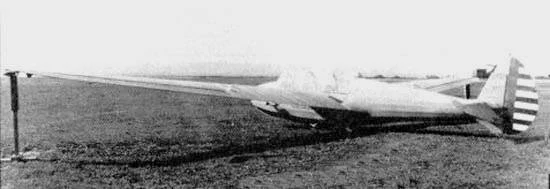 |
| General H.H. Arnold standing alongside a TG-2 glider, with Capt. Ralph S. Barnaby (left) and Edward S. Evans (right), at Harris Hill, Elmira, New York. 1941. |
 |
| TG-3A. The 2-12 succeeded the 2-8 in production and 114 were produced with the designation TG-3A. Three prototype TG-3s were constructed under the designation XTG-3. |
 |
| Schweizer TG-3A training glider. |
 |
| Schweizer TG-3A training glider, National Museum of the Air Force. |
 |
| Schweizer TG-3A (44-486136) training glider, U.S. Army Air Forces, Pima Air and Space Museum. |
 |
| The Laister-Kauffman TG-4A displayed at Air Mobility Command Museum. |
 |
| Laister-Kauffman TG-4A, Fort Rucker. 1942. |
 |
| Laister-Kauffman TG-4A. |
 |
| Laister-Kauffman TG-4A being readied for a factory test flight. |
 |
| Laister-Kauffman TG-4A on a factory test flight. |
 |
| Laister-Kauffman TG-4A. |
 |
| Laister-Kauffman TG-4A. Note the open rear canopy! |
 |
| Laister-Kauffman TG-4A. |
 |
| Laister-Kauffman TG-4A, “515,” contract glider school, Wickenberg, Arizona. Note the shark mouth on the nose. |
 |
| Laister-Kauffman TG-4A. |
 |
| Laister-Kauffman TG-4A. |
 |
| Laister-Kauffman TG-4A. |
 |
| Laister-Kauffman TG-4A. |
 |
| Laister-Kauffman TG-4A. |
 |
| Laister-Kauffman TG-4A during construction. |
 |
| Laister-Kauffman TG-4A during construction. |
 |
| Laister-Kauffman TG-4A hatch cover assembly. |
 |
| Laister-Kauffman TG-4A spoiler and brake system. |
 |
| Laister-Kauffman TG-4A tow hook — closed and open. |
 |
| Laister-Kauffman TG-4A — location of parachute tube. |
 |
| Laister-Kauffman TG-4A being inspected by General Yount, contract glider school, Lamase, Texas. |
 |
| Aeronca TG-5 training glider was a conversion of an Aeronca light plane by removing the engine and replacing it with a nose for a third crew member. |
 |
| Taylorcraft TG-6 (42-58662), U.S. Army. On display at the Pima Air and Space Museum. |




No comments:
Post a Comment